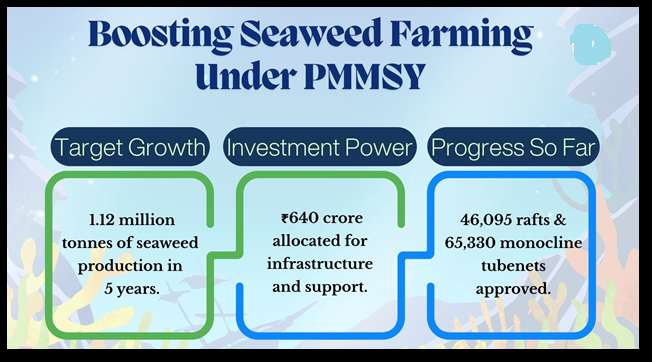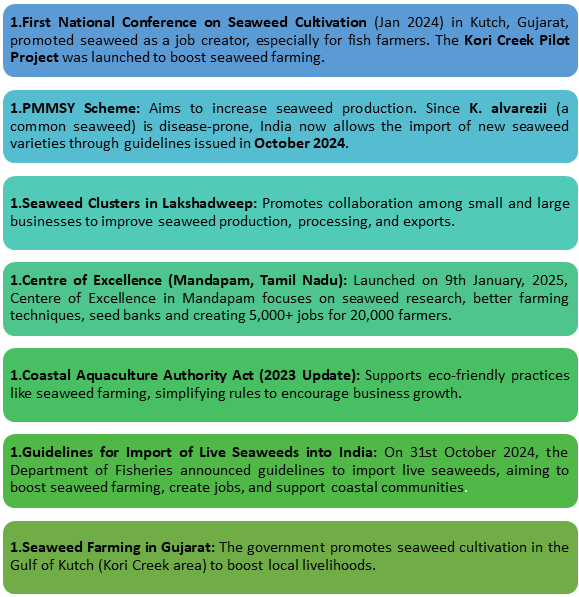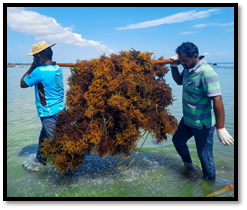Promoting seaweed farming in India
1. Vast Potential: India has a 7,500 km long coastline and a large Exclusive Economic Zone (EEZ), making it ideal for large-scale seaweed cultivation.
2. Eco-Friendly Farming: Seaweed farming requires no land, freshwater, fertilizers, or pesticides, making it highly sustainable and low-cost.
3. Nutrient-Rich Resource: Seaweed is rich in vitamins, minerals, amino acids, and 54 trace elements, with proven health benefits including immunity-boosting and disease prevention.
4. Global Industry Size: The global seaweed industry is worth $5.6 billion, with growing demand in food, pharmaceuticals, cosmetics, fertilizers, and biofuels.
5. India’s Untapped Potential: India has the capacity to produce up to 9.7 million tonnes of seaweed annually, yet currently contributes only a small share to the global market.
6. Employment Generation: Seaweed farming can generate over 6 lakh jobs, especially empowering women in coastal regions through self-help groups and cooperatives.
7. PMMSY Support: Under the Pradhan Mantri Matsya Sampada Yojana (PMMSY), the government aims to scale up production to 1.12 million tonnes in 5 years.
8. Infrastructure Development: The government is supporting the creation of seaweed nurseries, processing units, value chain infrastructure, and dedicated seaweed parks.
9. Target States: Coastal states such as Tamil Nadu, Gujarat, Maharashtra, Odisha, and Andhra Pradesh are identified as key seaweed farming zones.
10. R&D and Innovation: The National Seaweed Mission by the Department of Biotechnology focuses on technology development, commercialization, and sustainable practices to boost the sector.

Govt Initiatives of Seaweed Developments

key benefits of Seaweed production
1. Sustainable Livelihoods: Seaweed farming provides alternative and sustainable income opportunities for coastal communities, especially women and small-scale fishers.
2. Eco-Friendly and Climate-Resilient: Seaweed absorbs large amounts of CO₂, helping mitigate climate change. It also purifies seawater and supports marine biodiversity by offering shelter to aquatic life.
3. Biostimulants in Agriculture: Seaweed is recognized as one of the eight major biostimulants that boost plant growth, improve nutrient absorption, and enhance resistance to drought, pests, and diseases.
4. Regulated Under Fertilizer Control Order: The Fertilizer (Control) Order, 1985 ensures quality control of seaweed-based biostimulants, promoting their safe and effective use in Indian agriculture.
5. Boosts Organic Farming: Seaweed-based products are used as natural fertilizers and soil enhancers, aligning with government schemes like Paramparagat Krishi Vikas Yojana (PKVY) and MOVCDNER.
6. High Economic Returns: Cultivation of species like Kappaphycus alvarezii can earn farmers up to ₹13.28 lakh per hectare per year, offering a highly profitable income source.
7. Boosts Export Potential: Seaweed-based products such as biofuels, bioplastics, cosmetics, and fertilizers are in global demand, helping India earn valuable foreign exchange.
8. Supports Blue Economy: Seaweed farming aligns with India’s Blue Economy vision, promoting sustainable use of ocean resources for economic growth, livelihood, and ecosystem health.
9. Contributes to Food and Nutritional Security: Seaweed is rich in essential nutrients and trace elements, supporting nutritional health and offering potential for inclusion in food security programs.
Application of seaweed
1. Food Industry: Used as a superfood and dietary supplement due to its high content of vitamins, minerals, amino acids, and antioxidants. Popular in salads, soups, and snacks.
2. Pharmaceuticals & Healthcare: Contains bioactive compounds that help in managing cancer, diabetes, arthritis, heart disease, and boosting immunity.
3. Cosmetics & Personal Care: Widely used in skincare and haircare products for their hydrating, anti-ageing, and anti-inflammatory properties.
4. Agriculture (Biostimulants & Fertilizers): Used as organic biostimulants and soil conditioners, enhancing crop growth, improving soil health, and reducing dependency on chemical inputs.
5. Biofuel Production: Seaweed is a promising raw material for producing bioethanol and biogas, offering a sustainable alternative to fossil fuels.
6. Animal Feed: Added to livestock and aquaculture feed to improve nutrition, immunity, and digestion in animals.
7. Bioplastics and Packaging: Used in the development of biodegradable plastics, offering an eco-friendly solution to plastic pollution.
8. Water Purification & Carbon Sequestration: Seaweed farms help remove excess nutrients and heavy metals from seawater and absorb CO₂, contributing to cleaner oceans and climate action.
Challenges in seaweed farming
1. Lack of Awareness and Training: Many coastal communities are not fully aware of seaweed farming techniques, best practices, and economic potential.
2. Limited Access to Quality Seed and Infrastructure: There is a shortage of certified seaweed seedlings, nurseries, and cultivation infrastructure such as ropes, rafts, and boats.
3. Seasonal and Regional Constraints: Seaweed farming is often affected by seasonal variations, monsoons, and temperature-sensitive species, limiting year-round cultivation.
4. Environmental Concerns: Improper farming practices can lead to marine pollution, biodiversity disruption, and degradation of natural seaweed beds.
5. Weak Market Linkages and Price Fluctuations: Farmers face challenges in accessing reliable markets, resulting in unstable prices and low-profit margins.
6. Lack of Processing and Value Addition Facilities: Most coastal areas lack local processing units, limiting the ability to produce high-value products like biofertilizers, bioplastics, or cosmetics.
7. Regulatory and Policy Gaps: The absence of a comprehensive seaweed policy or clear coastal zone regulations creates confusion and delays in permissions and expansion.
8. Limited R&D and Innovation: Inadequate investment in research, species development, disease management, and modern cultivation technologies hamper productivity.
Way forward
1. Capacity Building & Awareness: Conduct targeted training programs, workshops, and awareness campaigns for coastal communities, especially women and youth, on seaweed cultivation and its benefits.
2. Develop Quality Seed Banks and Nurseries: Establish certified hatcheries and seed banks to ensure the timely availability of high-yield and disease-resistant seaweed varieties.
3. Promote Public-Private Partnerships (PPP): Encourage investment through PPP models in infrastructure, processing units, and value chains to enhance scalability and market access.
4. Strengthen Market Linkages: Create organized cooperatives, digital platforms, and tie-ups with industries to ensure fair prices and reduce market dependency.
5. Policy and Regulatory Framework: Formulate a comprehensive National Seaweed Policy aligned with coastal zone management, environmental sustainability, and livelihood promotion.
6. Invest in Research & Innovation: Support R&D in climate-resilient species, disease control, cultivation technologies, and value-added product development through institutions and startups.
7. Financial and Insurance Support: Provide subsidies, soft loans, and insurance coverage to seaweed farmers under schemes like PMMSY and Blue Economy initiatives.
8. Infrastructure Development: Develop dedicated Seaweed Parks, cold chain facilities, and processing units near farming clusters to improve post-harvest value addition and exports.
Conclusion







No Comments